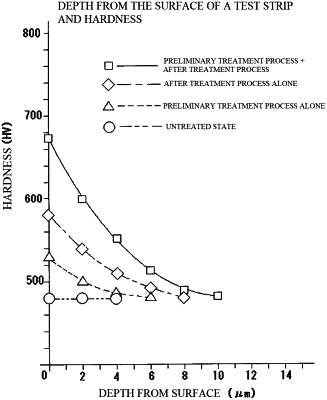| CPC B24C 1/06 (2013.01) [B24C 3/32 (2013.01); B24C 11/00 (2013.01); B29C 33/38 (2013.01); C23C 8/22 (2013.01); C23C 8/80 (2013.01)] | 2 Claims |

|
1. A method of treating a surface of a mold of base material of only metal with processing marks comprising:
a preliminary treatment process of dry-ejecting an angular carbide powder against the surface of the mold, of which the base material being of only metal, so as to cause elemental carbon present within the carbide powder to be diffused into the surface of the mold, the carbide powder having particle diameters not larger than those of a 220 grit particle distribution as defined by JIS R6001 (1987) and the carbide powder being dry-ejected at an ejection pressure of 0.2 MPa or greater; and
following the preliminary treatment process, an after treatment process of dry-ejecting a spherical powder against the surface of the mold after treatment by the preliminary treatment process so as to cause the spherical powder to impact the surface of the mold and form circular arc shaped depressions in the mold surface, the spherical powder having a hardness not less than the hardness of the base material, of only metal, of the mold and particle diameters not larger than those of a 220 grit particle distribution as defined by JIS R6001 (1987) and being dry-ejected at an ejection pressure of 0.2 MPa or greater,
as a result of performing both of the treatment processes, the processing marks are removed in a shorter time than when only the after treatment process is performed, and an adjustment that causes a hardness increase exceeding a sum of the hardness increase obtained only via the preliminary treatment process and the hardness increase obtained only via the after treatment process is performed.
|